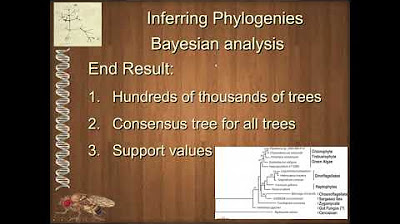Bayesian Learning
Summary
TLDRThe lecture introduces Bayesian probability and its applications. Key concepts like Bayes' Theorem, hypothesis testing, and probability calculation are explored using a cancer diagnosis example. The lecture delves into Bayesian learning, maximum likelihood hypothesis, and Gaussian distribution, demonstrating their role in finding optimal classifiers. Topics like linear regression, MAP hypothesis, and Gibbs sampling are also discussed, concluding with a focus on Bayes optimal classification and its importance. The session emphasizes understanding Bayesian methods for optimal data classification and decision-making.
Takeaways
- 🔍 Introduction to Bayesian probability, explaining its importance and applications.
- 📊 Detailed explanation of Bayes' Theorem, including its role in updating probabilities based on new evidence.
- 🧠 Use of a medical example to explain probability calculations, such as determining cancer risk based on test results.
- 🧮 Introduction to MAP (Maximum A Posteriori) Hypothesis and its application in Bayesian Learning.
- 🔢 Discussion on calculating posterior probabilities using given values and their implications.
- 📉 Explanation of linear regression and its use in predicting target functions.
- 🎯 Introduction to Maximum Likelihood Hypothesis and Gaussian distribution for hypothesis selection.
- 🧩 Explanation of Bayes Optimal Classifier and its use in classification problems.
- 🧪 Introduction to Gibbs Sampling as a method for hypothesis selection and optimization.
- 🔄 Emphasis on the process of hypothesis testing and validation using training and test data.
Q & A
What is Bayesian probability?
-Bayesian probability is a method of probability interpretation that updates the probability estimate as new evidence or information becomes available.
What is Bayes' theorem?
-Bayes' theorem describes how to update the probabilities of hypotheses when given evidence. It calculates the probability of a hypothesis based on prior knowledge and the likelihood of current evidence.
How does Bayes' theorem apply to medical testing for cancer?
-In the context of medical testing, Bayes' theorem can help calculate the probability that a patient has cancer, considering the prior probability (the general population’s cancer rate) and the test’s accuracy (sensitivity and specificity).
What is Maximum A Posteriori (MAP) hypothesis?
-MAP hypothesis refers to the hypothesis that maximizes the posterior probability, which is the likelihood of the hypothesis given the data and prior information.
What is the significance of the likelihood function in Bayesian analysis?
-The likelihood function measures how probable the observed data is under various hypotheses. It plays a critical role in updating beliefs about hypotheses based on the data.
What is the concept of Least Squares in linear regression?
-Least Squares is a method used to minimize the differences between observed data and the predicted values in linear regression by finding the line that best fits the data points.
What is the relationship between Gaussian distribution and Maximum Likelihood Hypothesis?
-When dealing with Gaussian distributions, the Maximum Likelihood Hypothesis is used to maximize the likelihood of data fitting a Gaussian model. It helps in estimating the parameters of the Gaussian distribution.
What is the role of Gibbs sampling in Bayesian classification?
-Gibbs sampling is used to approximate the posterior distribution in Bayesian classification. It generates samples from the distribution and allows for estimation when direct calculation is complex.
What is the Bayes Optimal Classifier?
-The Bayes Optimal Classifier is a classification model that makes predictions based on the posterior probabilities of all possible hypotheses. It is considered optimal as it minimizes the expected loss.
Why is the Bayes Optimal Classifier considered optimal?
-It is considered optimal because it uses the full posterior distribution of hypotheses, making it the most accurate classifier by minimizing classification errors in the long run.
Outlines

Dieser Bereich ist nur für Premium-Benutzer verfügbar. Bitte führen Sie ein Upgrade durch, um auf diesen Abschnitt zuzugreifen.
Upgrade durchführenMindmap

Dieser Bereich ist nur für Premium-Benutzer verfügbar. Bitte führen Sie ein Upgrade durch, um auf diesen Abschnitt zuzugreifen.
Upgrade durchführenKeywords

Dieser Bereich ist nur für Premium-Benutzer verfügbar. Bitte führen Sie ein Upgrade durch, um auf diesen Abschnitt zuzugreifen.
Upgrade durchführenHighlights

Dieser Bereich ist nur für Premium-Benutzer verfügbar. Bitte führen Sie ein Upgrade durch, um auf diesen Abschnitt zuzugreifen.
Upgrade durchführenTranscripts

Dieser Bereich ist nur für Premium-Benutzer verfügbar. Bitte führen Sie ein Upgrade durch, um auf diesen Abschnitt zuzugreifen.
Upgrade durchführenWeitere ähnliche Videos ansehen

Introduction to Bayesian Networks | Implement Bayesian Networks In Python | Edureka

BIOL 4330 Unit 2 1 2 Bayesian Analysis and Markov Chain Monte Carlo

39 - The gamma distribution - an introduction

Probability and Statistics: Overview

Binomial distributions | Probabilities of probabilities, part 1

[Statistika]: Macam-Macam Distribusi Probabilitas (Binomial, Poisson, Normal dan Student-T)
5.0 / 5 (0 votes)
